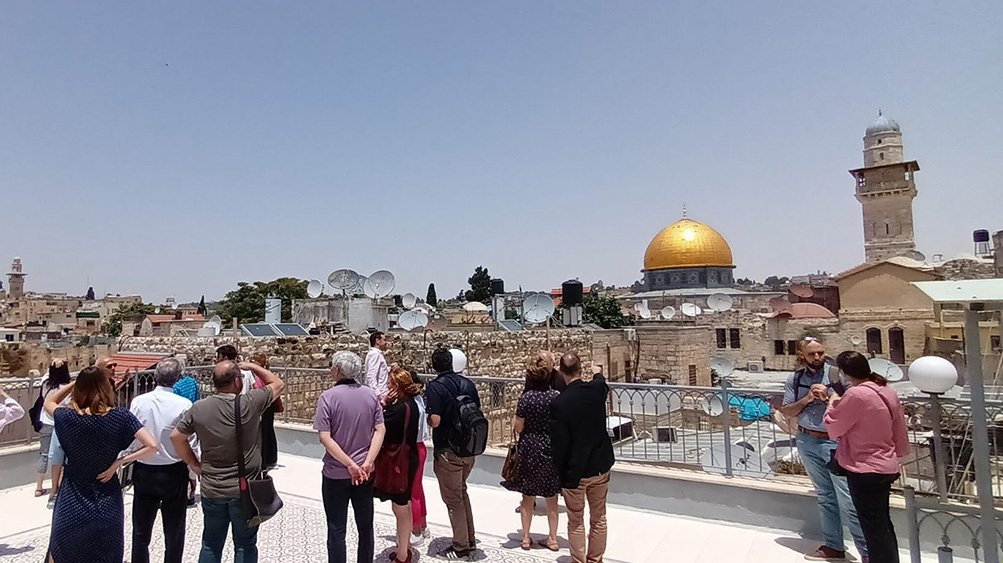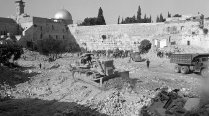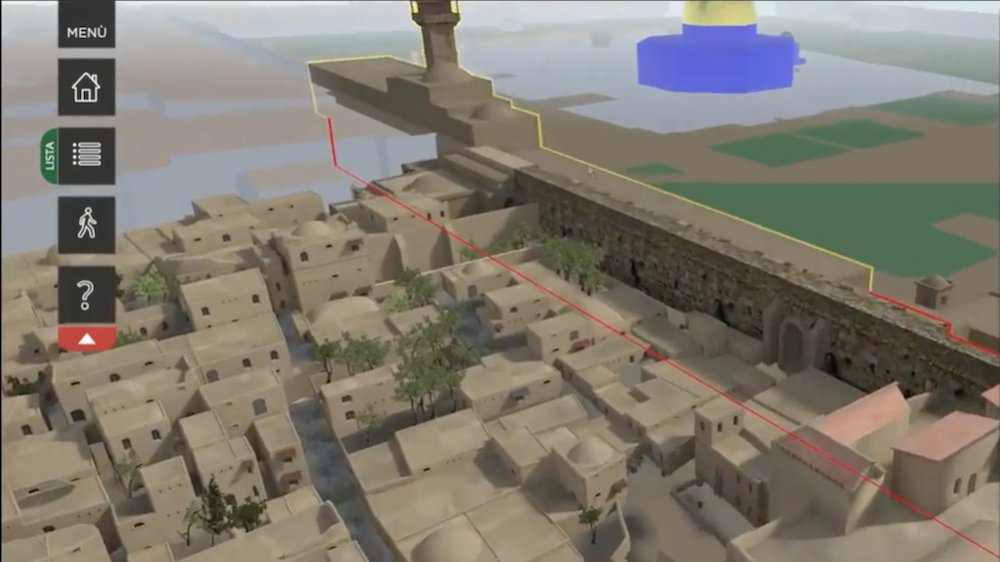Open Jerusalem, an EU-funded project publishing archival material of Jerusalem, hosted its first public symposium locally in the country on June 13–18, 2023. More than 400 people attended the series of events titled “Open Jerusalem Days,” in Gaza, Ramallah, Birzeit, and East Jerusalem.

Credit:
Open Jerusalem Facebook page
Open Jerusalem Project Unveils a Gateway to Jerusalem’s Past
“This journey from Gaza to Jerusalem to Birzeit and Ramallah is a symbolic one,” Vincent Lemire, historian at the University of Paris-Est Marne-la-Vallée as well as Open Jerusalem’s director, told the audience at the French Consulate in Jerusalem at the opening on June 13. “It’s a journey in the Palestine archipelago. And Open Jerusalem is one way to make connections between these points.”
Launched in 2014, Open Jerusalem seeks to locate the archives of Jerusalem’s history from 1840 to 1940 and make them available for public use. Its web catalog now provides access to 40,000 original documents written in 12 different languages and stored in 15 countries.
“Open Jerusalem Days” showcased various archival records from the Ottoman period, government and religious institutions, and Jerusalem’s foreign consulates as a way to reclaim history for Palestinians.
The rich schedule of geographically dispersed presentations, discussions, and events included “Unlocking Jerusalem’s History,” held symbolically in Gaza to provide access to their own history for those who cannot travel to Jerusalem; “Historiographical Uses of the Jerusalem Archival Database,” held at Birzeit University in order to link researchers of the Open University Project with those at the largest academic institution in Palestine; a press conference unveiling a 3D replica of the Maghrebi (Moroccan) Quarter, held at the American Colony Hotel in East Jerusalem, and more (see full program).
Archival Access for Those Who Are Denied It
Munir Fakher Eldin, dean of Birzeit University’s Faculty of Arts, described the project’s goal as “providing access to the archive for people who are denied access to their own city, to their own land.”
“In that sense, opening the Jerusalem archives is an extremely important political act in the direction of doing justice for the Palestinians,” Fakhr Eldin said.
One primary goal of the Open Jerusalem project is to make the archives accessible and to identify the best methods to achieve that.
“Digitalization is not equal openness,” Lemire said, referring to the Israel State Archives being currently closed for digitalization. Lemire explained during the panel on the historiographical uses of the archival database at Birzeit University that making archives available only through digital access actually limits the researcher’s knowledge.
“That’s why the Open Jerusalem project has a totally different strategy, which is to describe the document, to understand the history of the documents, and to help the researchers know what is shown and what is not shown,” Lemire said.
The “Memory Blackout” of the Maghrebi Quarter Expulsion
Open Jerusalem’s aim is not only to preserve history to better understand our present and future, but also to uncover untold history.
Using archival maps, GIS data, and historical photos, in partnership with 3D Research SRL, Lemire and other Open Jerusalem researchers were able to reconstruct a 3D digital model of the Maghrebi Quarter in Jerusalem’s Old City. The neighborhood located in front of the Western (al-Buraq) Wall was established in 1187 to house Muslim pilgrims from northwest Africa (the region called the Maghreb). Just days after conquering East Jerusalem on June 7, 1967, Israeli authorities ordered the expulsion of the hundreds of residents of the quarter in just two hours, and its demolition followed through the night of June 10. By then mayor of West Jerusalem Teddy Kollek’s own admission, they hired private contractors “to distance any involvement of official bodies in the demolition as much as possible.”1 The Maghrebi Quarter subsequently vanished from the Israeli historical narrative of the city.
Despite being an iconic image of Jerusalem—with the Dome of the Rock set behind the Western Wall—few know the Maghrebi Quarter’s history.
“Millions of people have already taken this very picture for decades, but 99 percent of the tourist pilgrims and even historians, tourist guides, and journalists didn't know,” Lemire said during a press conference on June 15 at the American Colony Hotel announcing the app’s launch. “For historians, this [is a] memory blackout.”2
The researchers gathered documentation from the Ottoman archives in Istanbul, Israel State Archives, archives of Muslim foundations in Jerusalem, French diplomatic archives, and the Red Cross in Geneva to give users an immersive experience of the streets, mosques, schools, and courtyards of the Maghrebi Quarter. Inside the app, users can walk through the streets, passing detailed doors and windows and viewing the ancient corniche; they can enjoy the gardens, fruit trees, and vegetation of the quarter; they can walk in front of the Western Wall. Information about key buildings is also provided.
The app can also be used on the web. It is available from WebGL, Google Play, and the Apple App Store.
Open Jerusalem partnered with the firm 3D Research SRL to develop the complex app.
In addition to the app, the neighborhood’s history is documented in Lemire’s new book, In the Shadow of the Wall (Stanford: Stanford University Press, 2023).
“We need to find the best way to spread the story to the public [and] break down this wall of silence and absence,” Lemire said at the press conference of the decision to create a 3D model of the quarter. He concluded, “This is just a work in progress. We have a lot more work to do—with inhabitant testimonies, archival documentation, and archeological data.”
Global Citizenry
The multicultural, multilingual, and multisite “Open Jerusalem Days” festival mirrored the project’s research team, which is made up of 60 researchers from around the world, but also Jerusalem’s position as a global and dynamic city.
“We don’t have the same histories, we don’t have the same passports, we don’t have the same identity, the same language, and maybe the same political agenda,” Lemire said. “It’s an open place. It’s a place where there are a lot of debates.”
Opening the archives gives the public the chance to learn about the different communities spread throughout Jerusalem and how their presence has impacted history.
“This is documentation that allowed not only to reconstruct diplomatic action, approach, and vision of France in Jerusalem and the region, but also to retrace the more ordinary elements coming from the consular records,” Maria Chiara Rioli, a historian and former Open Jerusalem project manager, said during the Consular and Diplomatic Records event at Jerusalem’s French Consulate.
One of the main goals of the Open Jerusalem project is addressing the concept of urban citizenship, the idea of civilian identity and rights being tied to a person’s city rather than their nation.3 In Jerusalem, where the demographic is split between a stateless population and immigrants, a better understanding of urban citizenry is vital.
“Urban citizenship basically concerns these archives of Jerusalem but also allows us to go far beyond Jerusalem within Palestine but also to neighboring areas,” Angelos Dalachanis, researcher at the French National Centre for Scientific Research (CNRS), said during his presentation at Birzeit University.
Jerusalem’s archives contain documents from other countries in addition to Jerusalem, thereby highlighting the international involvement in Jerusalem’s religious and political aspects. In this way, the archives define Jerusalem’s history as one of cross-cultural connection.
The Open Jerusalem database is more than just an accessible research tool, however. It also provides the city with a narrative—one that can often spur discussions still relevant today.
“It offers the historians the opportunity to connect through this historical archive and to shed light on the evidence taking place,” Stéphane Ancel, a CNRS historian, said when presenting at the Consular and Diplomatic Records session. “Part of the job of an historian is, of course, to study archives, but there is another part of an historian [which] is telling a story.”
Notes
Nir Hasson, “How a Small Group of Israelis Made the Western Wall Jewish Again,” Haaretz, June 3, 2017.
“Press Conference: The Maghrebi Quarter in 3D,” American Colony Hotel, June 15, 2023, Open Jerusalem Facebook page.
Harald Bauder, “Urban Citizenship: A Path to Migrant Inclusion,” Verfassungsblog, January 23, 2020.






